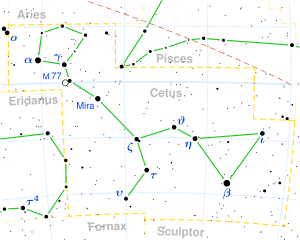Nu Ceti
 | |
| Observation data Epoch J2000.0 Equinox J2000.0 | |
|---|---|
| Constellation | Cetus |
| Right ascension | 02h 35m 52.473s[1] |
| Declination | +05° 35′ 35.69″[1] |
| Apparent magnitude (V) | 4.86[2] + 9.08 (visual companion)[3] |
| Characteristics | |
| Spectral type | G8III + F7V (visual companion)[4] |
| U−B color index | 0.52[2] |
| B−V color index | 0.88[2] |
| Astrometry | |
| Radial velocity (Rv) | 4.81±0.02[5] km/s |
| Proper motion (μ) | RA: −26.51±0.25[1] mas/yr Dec.: −22.32±0.22[1] mas/yr |
| Parallax (π) | 9.59 ± 0.23[1] mas |
| Distance | 340 ± 8 ly (104 ± 3 pc) |
| Absolute magnitude (MV) | −0.415[6] |
| Orbit[5] | |
| Primary | ν Ceti A |
| Period (P) | 714.48±0.15 days |
| Eccentricity (e) | 0.274±0.005 |
| Periastron epoch (T) | 53364.9±1.9 |
| Argument of periastron (ω) (secondary) | 119.5±1.1° |
| Semi-amplitude (K1) (primary) | 5.09±0.03 km/s |
| Details | |
| Mass | 1.1[6] M☉ |
| Temperature | 4800[6] K |
| Other designations | |
| Database references | |
| SIMBAD | data |
Nu Ceti (ν Ceti), is a spectroscopic binary located in the constellation Cetus. Nu Ceti is believed to be part of the Ursa Major stream.
In Chinese, 天囷 (Tiān Qūn), meaning Circular Celestial Granary, refers to an asterism consisting of α Ceti, κ1 Ceti, λ Ceti, μ Ceti, ξ1 Ceti, ξ2 Ceti, ν Ceti, γ Ceti, δ Ceti, 75 Ceti, 70 Ceti, 63 Ceti and 66 Ceti. Consequently, ν Ceti itself is known as the Seventh Star of Circular Celestial Granary, Tiān Qūn Qī.[7]
In addition to the spectroscopic companion there is a visual companion star which shares a common proper motion with Nu Ceti A, Nu Ceti B, an F7V dwarf star with 9.08 apparent visual magnitude and located 8.0 arcsec away. It was discovered by Struve.[5][3]
References
- 1 2 3 4 5 van Leeuwen, F. (2007). "Validation of the new Hipparcos reduction". Astronomy and Astrophysics. 474 (2): 653–664. arXiv:0708.1752. Bibcode:2007A&A...474..653V. doi:10.1051/0004-6361:20078357. Vizier catalog entry
- 1 2 3 Cousins, A. W. J. (1963). "Photometric Data for Stars in the Equatorial Zone (Third List)". Monthly Notes of the Astronomical Society of Southern Africa. 22: 12–17. Bibcode:1963MNSSA..22...12C.
- 1 2 Lutz, T. E.; Lutz, J. H. (1977). "Spectral classification and UBV photometry of bright visual double stars". The Astronomical Journal. 82: 431–434. Bibcode:1977AJ.....82..431L. doi:10.1086/112066.
- ↑ Stephenson, C. B.; Sanwal, N. B. (1969). "The masses of stars above the main sequence". The Astronomical Journal. 74: 689–704. Bibcode:1969AJ.....74..689S. doi:10.1086/110845.
- 1 2 3 Griffin, R. F. (2015). "Spectroscopic binary orbits from photoelectric radial velocities. Paper 240: BD+59 224, HD 9592, HD 10171, HD 11738, and nu Ceti". The Observatory. 135: 15–41. Bibcode:2015Obs...135...15G.
- 1 2 3 "Nu Ceti". Archived from the original on 2013-02-26.
- ↑ (in Chinese) AEEA (Activities of Exhibition and Education in Astronomy) 天文教育資訊網 2006 年 7 月 11 日
External links
- http://server3.wikisky.org/starview?object_type=1&object_id=1566
- http://www.alcyone.de/SIT/bsc/HR0754.html
This article is issued from
Wikipedia.
The text is licensed under Creative Commons - Attribution - Sharealike.
Additional terms may apply for the media files.